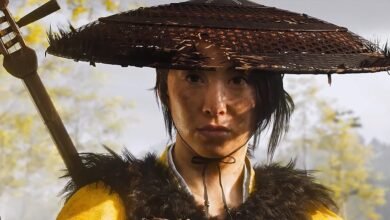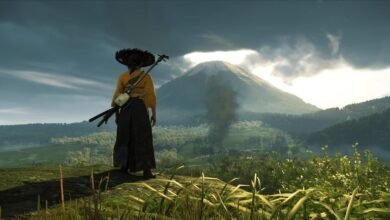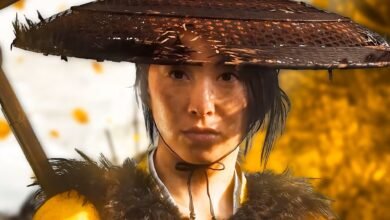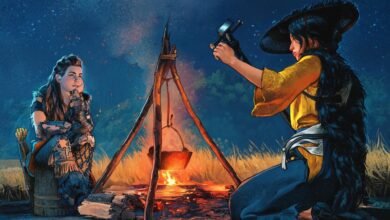Ghost Of Yōtei Creators On Atsu: ‘A Chapter Is Done’
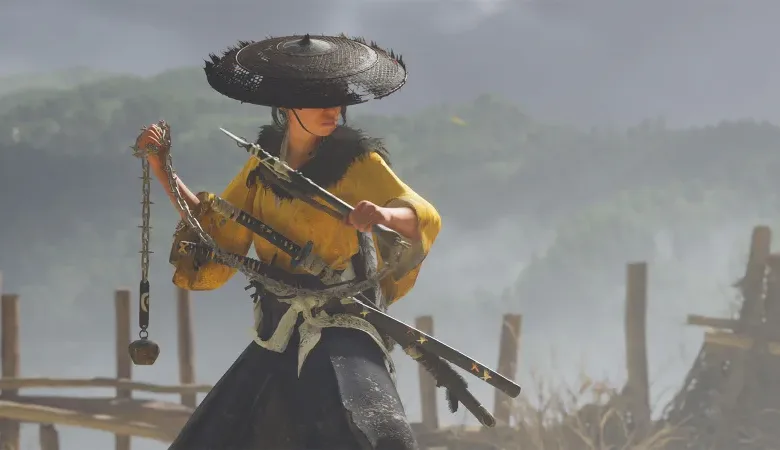
▼ Summary
– The game features a pivotal scene where protagonist Atsu connects with Oyuki, exploring themes of mercy and shared trauma instead of immediate revenge.
– Atsu’s brother Jubei is revealed to be alive, and their reconnection is central to the story, with players potentially discovering this early based on their path choices.
– The developers intentionally created a single, definitive ending for Atsu’s story to reflect her journey of sacrifice, healing, and new responsibilities, rather than offering multiple endings.
– Actor Erika Ishii significantly influenced Atsu’s character through workshops and improvisation, helping shape her as a relatable, wandering warrior with depth and compassion.
– The team included hidden murals and references to previous Sucker Punch games as Easter eggs, added passionately by team members without a formal approval process.
Exploring the rich narrative world of Ghost of Yōtei reveals a deeply personal journey centered on protagonist Atsu, whose quest for revenge transforms into a path of healing and self-discovery. With the game now available for several weeks, players have experienced its emotional conclusion, prompting discussions with the creative team about its most compelling story elements and potential future directions.
Game Informer: Let’s address spoilers directly. The musical scene between Atsu and Oyuki stands out as profoundly moving, even bringing some players to tears. What went into crafting that sequence and what were its core objectives?
Ian Ryan: We aimed to construct a narrative where Atsu had to engage with a member of the Six on a personal level, rather than simply eliminating them. Forcing her to step outside her comfort zone and perceive the world through Oyuki’s perspective was crucial. This allowed Atsu to recognize that others also suffered under Lord Saito, even if Oyuki played a role in her family’s tragedy. The moment Atsu identifies Oyuki culminates in training, conflict, and a test of her capacity for mercy. We wanted to honor her anger and sense of betrayal while exploring whether she could extend forgiveness. This wasn’t about full absolution, but about acknowledging shared pain and allowing Atsu to heal slightly, moving beyond her instinct for vengeance.
The revelation that Atsu’s brother Jubei survived came as a shock. Was this intended as a major twist, and how vital was his role to Atsu’s overall arc? Did you want players to encounter him early?
Jason Connell: Depending on player choices, that reveal can happen quickly or much later. If you follow the golden path or prioritize certain storylines, you might meet him sooner. We felt showing their relationship early, if players chose that route, was valuable. Noshir Dalal’s performance brings their bond to life beautifully. The Ishikari Plain segment delves into their reconnection and the challenges of their separate lives, so establishing their dynamic upfront enriched the emotional depth of their journey together.
Did you implement any subtle guidance to steer players toward discovering Jubei’s story first?
Jason Connell: Some underlying systems may nudge players toward certain starting points, but geography plays the biggest role. The Oni storyline is simply closer than the distant Kitsune quest in the north. If players see two intriguing options, they often pick the nearer one. We appreciate that freedom, but if we were to impose linearity, introducing Jubei first makes narrative sense. His relationship with Atsu contrasts sharply with her dynamic with Oyuki, so experiencing it early helps frame the story effectively.
Jubei having a daughter, Kiku, was another surprise, yet Kiku’s mother received little attention. What informed that decision?
Ian Ryan: We briefly address her mother’s fate during a quiet moment on Oshima coast, revealing she died in childbirth. Jubei’s brief involvement left him a young, unprepared father. With so many characters to develop, we concentrated on those directly involved in the current narrative. Kiku’s mother’s absence is felt, influencing how Atsu steps into a nurturing role for her niece.
Many players find Atsu more compelling than Ghost of Tsushima’s Jin Sakai. What was your approach to making her so relatable and engaging?
Ian Ryan: We set out to create an outsider whose personal story would resonate deeply. Despite the larger conflict involving samurai factions and Lord Saito, we prioritized Atsu’s emotional journey, her revenge mission and her struggle to mend a wounded heart. Erika Ishii’s incredible performance brought authenticity and depth to the character. We drew inspiration from wandering warrior archetypes in American and spaghetti westerns, as well as figures like Mifune’s Yojimbo, a mercenary with hidden compassion who recognizes fellow sufferers and chooses to aid them.
How was Erika Ishii cast, and what influence did she have on shaping Atsu? Is improvisation encouraged during video game performances?
Jason Connell: Absolutely. We held workshops with Erika to refine the character collaboratively. Casting sought someone who could embody the written role while adding unexpected layers or flaws. Seeing an actor bring unscripted passion or nuance to a scene excites us. Once cast, Erika spent months merging her own personality with Atsu’s, resulting in a creative partnership that evolved beautifully. Nate Fox, our stage director, values improvisation and often gave actors a final take to experiment, frequently, those improvised moments became the selected takes, enriching the creative process.
The extended sequence about Jin Sakai, detailing his post-Tsushima fate, was a welcome surprise. When did you decide to include it?
Jason Connell: It emerged relatively early in development. Once Atsu’s revenge-driven story was solidified, we recognized an opportunity to honor Jin through our mythic tales tradition. Our team adores Jin and his story, so crafting a sendoff for him was a labor of love. We aimed to give fans a satisfying conclusion while offering new players a glimpse into his legacy, perhaps enticing them to explore Tsushima.
With fan theories speculating about Jin’s spiritual form before release, was it difficult to avoid confirming he was more fox than wolf?
Jason Connell: It’s always challenging when fans guess correctly or come close. You just have to smile and stay quiet, players are incredibly sharp.
Ghost of Tsushima featured multiple endings. Did you contemplate branching conclusions for Yōtei?
Ian Ryan: We evaluated every possibility for the ending, reflecting on what succeeded in Tsushima. However, Atsu’s arc demanded a specific resolution. Her journey through revenge and healing led us to a conclusion where she sacrifices certain hopes, mirroring her initial loss. We emphasized player agency throughout the game, but the finale illustrates how her choices inevitably lead to losing Jubei, despite her desires. Now responsible for her niece Kiku, Atsu must embody Jubei’s “fight for the living” philosophy. While we cherished Jubei, the narrative didn’t support his survival, and we avoided arbitrary choices at the climax.
Do you view Atsu’s story as complete?
Ian Ryan: I see this as a concluded chapter, but her future holds much more. She’s learning to live without her brother, acting as a surrogate mother to Kiku. Revenge is behind her, yet she isn’t fully healed. Her path forward won’t be smooth, and that uncertainty makes her relatable.
This subtly hints at potential single-player DLC. Is that something you’re considering?
Jason Connell: We’re currently observing what resonates with players, what they love and what gaps they identify. Similar to Tsushima, fan feedback helps us understand where to deepen Atsu’s narrative. If expanding her story aligns with Sucker Punch’s goals and enhances the character, we’ll seriously consider it.
How do you feel about the game’s reception? Is it a relief to finally release it?
Jason Connell: Our launch party was celebratory, seeing the team rejoice together was wonderful. Game development is arduous, and delivering a title that improves upon its predecessor is rewarding. Criticism, while tough to hear, ultimately hones our craft. I’m immensely proud of what everyone achieved, and the positive response fills me with gratitude.
Ian, how are you feeling now that Yōtei is out?
Ian Ryan: I share Jason’s relief and pride. After such an intensive journey, it’s thrilling to see players engage with the world we built. The team’s monumental effort, especially in the final stages, created something magical. Introducing a new protagonist was a risk, and the enthusiastic response to Atsu and our more open world design has been incredibly validating. Feedback, both positive and critical, helps us grow.
Jason Connell: After five years of development, hearing from fans who invested in the game offers a new perspective. It’s a rewarding phase, and we’re grateful to be here.
The game features murals referencing previous Sucker Punch titles. How did you select which ones to include?
Jason Connell: The process was wonderfully organic. A team member named Harold, along with others, took initiative, since these are our IPs, they placed murals in interesting locations without a formal committee. I discovered several by accident, which delighted me. The same applies to sword kits, like the Infamous-inspired design. These touches reflect the team’s passion and creative freedom, and I love that they emerge spontaneously.
The Sir Raleigh mural from Sly Cooper was especially amusing. Focusing on a specific villain felt particularly clever.
Jason Connell: Harold provided a list since I haven’t found them all. The inclusion of Rocket from Robot on Wheels, Sucker Punch’s first game, was a surprise I truly appreciated.
Was a romantic partner ever considered for Atsu?
Ian Ryan: We discussed it, but always returned to Atsu’s emotional state. Given her history of betrayal and trauma, she wouldn’t readily open herself to romance during her hunt for the Yōtei Six. She’s only beginning to lower her guard and trust others. While she’s had past physical relationships, pursuing deep romance didn’t fit her current journey. Perhaps in a future chapter, post-revenge, that could change.
(Source: Game Informer)
